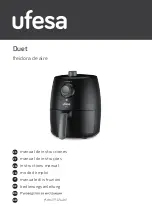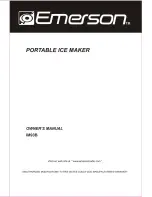
55.
54.
Bread Maker Use and Care Guide
Before Calling For Service
Questions and Answers
Questions Answers
Why does the height and shape
The height and shape of bread may differ
of bread differ in each loaf?
depending on the ingredients, room
temperature and length of the timer cycle. Also
accurate measurement of ingredients is
essential to make delicious bread.
The bread has an unusual
Stale ingredients or too much yeast may have
aroma. Why?
been used. Always use fresh ingredients.
Accurate measurements are essential to make
delicious bread.
The kneading blade comes out
This may happen as the kneading blade is
with the bread.
detachable. Use a non-metal utensil to
remove it.
Caution:
The kneading blade will be hot.
The baked loaf of bread has a
Sometimes flour in the corner of the pan may
floured corner.
not have been completely kneaded into the
dough. Scrape the flour off the loaf with a
spatula.
Why can the timer not be set for
Longer delay times could alter the baking
more than 13 hours?
results.
Can ingredients be halved or
No. If there is too little in the pan, the knead-
doubled?
ing blade cannot knead well enough. If there is
too much, bread swells out of the pan.
Can fresh milk be used in place
Yes, for all programs except FAST BAKE
™
. Be
of dry milk?
sure to deduct the same measurement of water
to equal liquid substitution (warm to
80°F/27°C). Fresh milk is not recommended
when using the timer, because it may spoil
while setting in the pan.
Why is the display flashing E:01?
The bread machine cavity needs to cool down
before making the next loaf of bread.
1
2
3
4
5
6
7
8
Cleaning & Storing
ALWAYS UNPLUG THE UNIT AND ALLOW TO COOL COMPLETELY BEFORE CLEANING.
CAREFULLY UNPACK THE BREAD MAKER AND REMOVE ALL PACKAGING MATERIALS.
Any service requiring disassembly, other than the cleaning described below, must be performed by an
authorized service center. Unauthorized service will void your warranty.
Cleaning
CLEAN-UP OF BREAD MAKER
1. Unplug and allow to cool before cleaning.
2. Remove bread pan from inside the bread maker.
3. Clean exterior of bread maker with a damp cloth and plastic scouring pad if necessary. Do not rub
too hard as the surface may be scratched.
4. Remove any flour, bread crumbs or other food from the inside of the oven cavity using a damp
sponge, cloth or a small portable vacuum cleaner. A plastic scouring pad may be used if necessary.
Do not rub too hard as the surface may be scratched.
5. To clean the glass in the lid, use a glass cleaner or mild detergent and a damp cloth or plastic
scouring pad. Do not use an abrasive cleaner or pad as they might scratch the glass.
6. Rinse with a damp cloth and dry thoroughly.
CLEAN-UP FOR OVER-RISING
1. If the bread should over-rise and hit the cover, extra cleaning will be necessary. Unplug the bread
maker and gently remove cover. Using a nylon spatula or wooden utensil, scrape all loose dough
from inside the cover. Then wash the cover in warm, soapy water.
2. Move bread maker to countertop next to kitchen sink; place on backside. You may want to place it
on a towel to avoid scratching it. Use a pastry brush to “sweep” crumbs from inside the bread maker
and around the hinges. Wipe inside of bread maker with a damp cloth.
3. Using a wet dishcloth or sponge, soak all remaining dry or burned-on dough to loosen. Use a plastic
scrub pad to remove any stubborn spots. Do not use abrasive cleaners or metal scouring pad which
could damage the finish. Rinse well with a damp dishcloth or sponge and dry thoroughly. If any
water has accumulated in the vent of the cover, wipe with a dishcloth or sponge to prevent it from
running down the inside or outside of the bread maker when you stand the unit upright. Carefully
insert cover tabs into the slots and snap into place.
CLEAN-UP OF BREAD PAN AND KNEADING BLADE
DO NOT IMMERSE BREAD PAN OR WASH IN DISHWASHER
1. Allow to cool before cleaning.
2. Fill with hot soapy water and remove kneading blade. If necessary to remove the kneading blade
from the bread pan, allow the soapy water to remain in the pan for up to 30 minutes (longer times
may damage the non-stick surface). It is not necessary to remove the kneading blade for cleaning.
However, if you wish to, it is necessary to do so after each use or it will become increasingly difficult
to release.
3. Wash bread pan and kneading blade with a nylon bristle brush. Do not use steel wool, abrasive
cleaners, or metal utensils on the bread pan or kneading blade as they will damage the non-stick
surface. Normal wear is to be expected. The non-stick may discolor over time and in no way affects
performance.
STORING
◆
All removable parts should be thoroughly cleaned and dried.
◆
Store with lid closed and kneading blade inside bread pan.










































